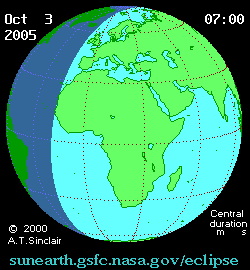Nature Annular Magnitude 0.9576 Max. width of band 162 km (101 mi) Date 3 October 2005 | Gamma 0.3306 Duration 272 sec (4 m 32 s) (P1) Partial begin 3:53:56 | |
 | ||
Other Instances Solar eclipse of April 8 - 2, Solar eclipse of July 2 - 20, Solar eclipse of August 2, Solar eclipse of March 9, Solar eclipse of March 20 | ||
An annular solar eclipse occurred on October 3, 2005 with a magnitude of 0.958. A solar eclipse occurs when the Moon passes between Earth and the Sun, thereby totally or partly obscuring the image of the Sun for a viewer on Earth. An annular solar eclipse occurs when the Moon's apparent diameter is smaller than the Sun's, blocking most of the Sun's light and causing the Sun to look like an annulus (ring). An annular eclipse appears as a partial eclipse over a region of the Earth thousands of kilometres wide. It was visible from a narrow corridor through the Iberian peninsula and Africa. A partial eclipse was seen from the much broader path of the Moon's penumbra, including all of Europe, Africa and southwestern Asia.
Contents
The path of the eclipse began in the North Atlantic ocean at 08:41 universal time (UT). The antumbra reached Madrid, Spain at 08:56 UT, lasting four minutes and eleven seconds and 90% of the Sun was covered by the Moon. The antumbra reached Algiers at 09:05 UT, then passed through Tunisia and Libya before heading southeast through Sudan, Kenya and Somalia. The shadow then moved out over the Indian Ocean until it terminated at sunset, 12:22 UT.
The maximum eclipse duration occurred in central Sudan at 10:31:42 UT, where it lasted for 4m 31s when the Sun was 71° above the horizon. The theoretical maximum duration for a modern solar eclipse is 7 minutes, 32 seconds.
The motion of the shadow was supersonic and it generated gravity waves that were detectable as disturbances in the ionosphere. These gravity waves originate in the thermosphere at an altitude of about 180 km. Because of the obscuration of solar radiation, the ionization level dropped by 70% during the eclipse. The eclipse caused a 1–1.4 K drop in the temperature of the ionosphere.
Degania A, Israel : Partial
Solar eclipses 2004-2008
Each member in a semester series of solar eclipses repeats approximately every 177 days and 4 hours (a semester) at alternating nodes of the Moon's orbit.
Saros 134
It is a part of Saros cycle 134, repeating every 18 years, 11 days, containing 71 events. The series started with partial solar eclipse on June 22, 1248. It contains total eclipses from October 9, 1428 through December 24, 1554 and hybrid eclipses from January 3, 1573 through June 27, 1843, and annular eclipses from July 8, 1861 through May 21, 2384. The series ends at member 71 as a partial eclipse on August 6, 2510. The longest duration of totality was 1 minutes, 30 seconds on October 9, 1428.
Metonic cycle
The metonic series repeats eclipses every 19 years (6939.69 days), lasting about 5 cycles. Eclipses occur in nearly the same calendar date. In addition the octon subseries repeats 1/5 of that or every 3.8 years (1387.94 days).
